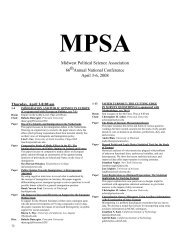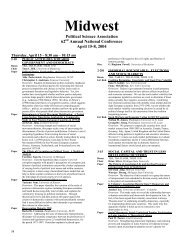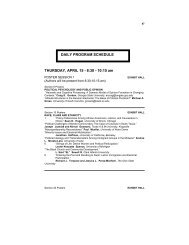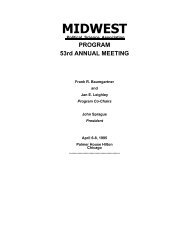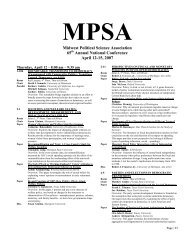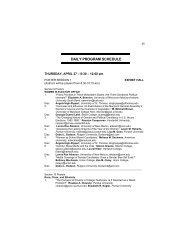18-14 THE STUDY AND MEASUREMENT OFRACIAL ATTITUDESRoomChairPaperPaperPaperPaperDisc.TBA, Sun 10:30 amShayla C. Nunnally, University of ConnecticutOn the Meaning and Measurement of <strong>Political</strong> Values: ACritical AssessmentChristopher S. Parker, University of California, SantaBarbara/Robert Wood Johnson Health Policy ScholarOverview: This paper challenges whether or not a second-orderfactor representing political culture is possible, and whether itsmeasurement is affected by race.Color-Blind Policies or Color-Infused Principles: AnExperimentInna Burdein, Stony Brook UniversityOverview: This experiment addresses competing hypotheseswithin racial literature: (a) conservatives rely on their principlesin making policy decision, regardless of race, or (b)conservatives abandon their principles when policies benefitminorities.Race on the Brain: A Functional MRI Study of RacialPerceptionDarren Schreiber, University of California, San DiegoOverview: MRI has proven to be a useful tool for examiningracial attitudes. This study adds nuance to this line of researchby focusing on the neural correlates of perception of White andBlack political figures.Social Groups and Social Desirability: Measuring Groupand Question Stimulus EffectsChristopher P. Muste, University of MontanaOverview: Survey experiments are used to assess two types ofsocial desirability effects: the effect of social group cures ofrace, sex, and class; and the effect of questions tapping socialgroup affiliations compared to perceptions of social groupinfluence.John E. Transue, Duke University19-9 INFORMED VOTING?RoomChairPaperPaperPaperPaperTBA, Sun 10:30 amRichard R. Lau, Rutgers UniversityHearing the Campaign: Candidate Messages, PublicPerceptions, and Public PrioritiesMichele P. Claibourn, University of VirginiaOverview: Do citizens accurately hear the issue content of thepresidential advertising campaign? Do they prioritize the issuescandidates emphasize in their advertising campaigns?An Exploration of Correct Voting in U.S. PresidentialElections, 1972 - 2004Richard R. Lau, Rutgers UniversityDavid J. Andersen, Rutgers UniversityDavid P. Redlawsk, University of IowaOverview: This paper presents a comprehensive examination ofcorrect voting in U.S. presidential elections, 1972 - 2004. Threesets of predictors are considered: individual (cognitive)capacity, task difficulty, and the complexity/density of theinformation.Too Many Bush Voters? False Vote Recall and the 2004 ExitPollMark Lindeman, Bard CollegeOverview: The 2004 NEP exit poll indicates that 2004 votershad substantially favored George W. Bush over Al Gore in 2000– an "impossible" result that some took as evidence of fraud.How anomalous is the result, and how should it influenceelection analysis?Campaign Effects and Correct VotingScott D. McClurg, Southern Illinois University, CarbondaleTom Holbrook, University of Wisconsin, MilwaukeeOverview: We examine the effect of presidential campaigns onthe probability of voting correctly.PaperDisc.Consumption of Ideology and Voting HeuristicsX. T. Wang, University of South DakotaOverview: The study examined how different choice heuristicsaccounted for participants' presidential choice two monthsbefore the 2004 election. A few simple heuristics did better inpredicting the overall winner of the voting than normativedecision rules.William G. Jacoby, Michigan State University22-9 SHORTCUTS TO POLITICALKNOWLEDGERoomChairPaperPaperPaperDisc.TBA, Sun 10:30 amPaul Goren, Arizona State UniversityThe Military Vote: Security Threats and Candidates'Veteran Prestige as DeterminantsJohn M. Fulwider, University of Nebraska, LincolnOverview: The military votes like civilians, except in times ofthreat. Further, they aren't swayed by a candidate's militarybackground. This will affect the electoral prospects of the firstgroup of veterans since Vietnam to enter politics in largenumbers.Cue-based Versus Message-based <strong>Political</strong> Persuasion:Evidence From a SurveyRune Slothuus, University of Aarhus, DenmarkOverview: A national representative election survey allows meto disentangle the persuasive effects of changing arguments inpolitical messages, while holding the partisan source constant,thus illuminating cue-based versus message-based opinionchange.Cues Given, Cues Received: How Candidates Use ShortcutsWhen Voters Need Them MostJeff M. Tessin, Princeton UniversityOverview: This paper shows that House candidates use morecues and heuristics in their ads in crowded media markets andunsophisticated districts. Thus, candidates may help citizencompetence by providing messages suited for low-informationconditions.Paul Goren, Arizona State UniversityWendy Rahn, University of Minnesota23-2 CROSS-NATIONAL VOTER TURNOUT ANDPOLITICAL PARTICIPATIONRoomChairPaperPaperPaperTBA, Sun 10:30 amMiki Caul Kittilson, Arizona State UniversityVoter Equality in Post-Industrialized Nations: TheInteraction of Individual Resources and <strong>Political</strong> ContextMiki Caul Kittilson, Arizona State UniversityMark M. Gray, Georgetown UniversityOverview: We draw on the cross-national Comparative Study ofElectoral Systems data set to examine how political institutionsand organizations interact with individual-level resources inshaping an individual's propensity to vote.European Parliament Electoral Turnout in Post-CommunistEuropeMary A. Stegmaier, University of VirginiaChristine Fauvelle-Aymar, Universite de Paris IOverview: Turnout rates in the 2004 European Parliamentelection in the post-communist states averaged 32.5% andranged from 17% in Slovakia to 48% in Lithuania. Usingdistrict-level data, we assess the factors that explain the variancein turnout rates.What Makes Compulsory Voting Mandatory? A Cross-National Study of Compulsory Voting and Turnout, 1970-2004James W. Endersby, University of Missouri, ColumbiaJonathan T. Krieckhaus, University of Missouri, ColumbiaOverview: On average, compulsory voting increases nationalvoter turnout by about ten percent. However, the influence ofmandatory voting laws depends on the penalty imposed, thelevel of enforcement, the extensiveness of coverage, and thelevel of democracy.264
PaperDisc.Social Capital and <strong>Political</strong> ParticipationMaria Elena Sandovici, Lamar UniversityOverview: This paper explores the relationship betweenpolitical participation and social capital. It argues that socialnetworks facilitate participation, and trust shapes the choicebetween conventional and unconventional action.TBA24-16 AGENDA SETTING AND THE MEDIARoomChairPaperPaperPaperDisc.TBA, Sun 10:30 amJohanna L. Dunaway, Rice UniversityWhose Agenda Wins Out? The Effects of Candidate andMedia Issue AttentionDanny Hayes, University of Texas, AustinOverview: I identify the circumstances under which one groupof elites -- candidates or journalists -- is more likely to succeedin setting the public's agenda, as well as the ways individuallevelfactors condition a person's susceptibility to agendasetting.Does the Media Agenda Reflect the Candidates' Agenda?Travis N. Ridout, Washington State UniversityRob B. Mellen, Washington State UniversityOverview: Using coding of local news broadcasts, statewidenewspapers, candidate ads and candidate websites, this paperexamines the degree of congruence between the candidates'issue agenda and the media's issue agenda in the 2002 U.S.Senate campaigns.Entertain Their Brain: Selling <strong>Political</strong> Agenda UsingEntertainment ValuesMichael D. Todd, Southern Illinois University, CarbondaleOverview: This paper is an analysis of how nightly newsprograms are using entertainment and marketing techniques topresent President Bush's War on Terror to the viewer and withwhat effect.Linda Bennett, University of Southern Indiana25-14 DESCRIPTIVE AND SUBSTANTIVE VIEWSOF WOMEN'S REPRESENTATIONRoomChairPaperPaperPaperDisc.TBA, Sun 10:30 amKatherine Opello, Hollins UniversityWomen's <strong>Political</strong> Mobilization in Ethnic Conflicts:Theoretical ConsiderationsLinda Racioppi, Michigan State UniversityKatherine O. See, Michigan State UniversityOverview: This paper explores women's political mobilizationunder conditions protracted ethnic conflict. It examines howethnic conflict shapes and constrains activism and politicalparticipation and how such conflict limits movements forwomen's equality.Explaining French Parties' Response to the Parity LawRainbow Murray, Birkbeck College, University of LondonOverview: This paper examines the French parity law from theperspective of political parties. Existing theoretical approachesare used in conjunction with individual party priorities toprovide a fuller explanation of parties’ choice of electoralcandidates.Critical Acts or Critical Mass? Female Deputies' Impact onPolicy in FranceKatherine Opello, Hollins UniversityOverview: This paper examines whether women in the FrenchNational Assembly affect policy. It posits that demands for andpassage of "women friendly" policies are due to the critical acts(rather than a critical mass) of female deputies.Manju Parikh, College of Saint Benedic/Saint John'sUniversity26-7 AFRICAN AMERICAN POLITICALPARTICIPATIONRoomChairPaperPaperPaperPaperDisc.TBA, Sun 10:30 amDamon Freeman, University of PennsylvaniaConsidering <strong>Political</strong> Socialization Among AfricanAmerican YouthZahra G. Ahmed, University of California, IrvineOverview: This paper conceptualizes five research dimensionsof the political socialization literature. A critique follows eachdimension in the context of its utility for understanding politicalconsciousness development among African American youth.Black Ethnicity: <strong>Political</strong> Attitudes, Incorporation, andParticipationChristina M. Greer, Columbia UniversityOverview: An analysis of political attitudes and participation ofblack American, African Immigrant, and Afro-CaribbeanImmigrant members of the Social Services Employees Union -Local 371 in New York City, NY.Uplift Revisited: Barack Obama and Black Progress inAmericaGayle McKeen, University of the South, SewaneeOverview: This paper sets the recent wave of uplift ideologyarticulated by black leaders such as Obama in the context ofAfrican-American political thought and examines the recentshift from civil rights to self-help discourse.Advocacy on Behalf of the Poor: Elite Influence onOrganizational BehaviorCatherine Paden, Northwestern UniversityOverview: I compare the NAACP's and NUL's responses to the1964 Economic Opportunity Act and the 1988 Family SupportAct. I argue that the organizations’ changing relationship withelites affected their advocacy on behalf of the poor during the1980s.Mark Q. Sawyer, University of California, Los Angeles27-16 LIBERALISM, COMMUNITARIANISM,PLURALISMRoomChairPaperPaperPaperPaperDisc.TBA, Sun 10:30 amEric MacGilvray, University of Wisconsin, MadisonThe Ideas of Roscoe Pound: Pragmatism, Pluralism andPolylegalismRoger J. Cusick, University at AlbanyOverview: This paper examines the life and writings of RoscoePound (1870-1964). It focuses upon his largely overlookeddecisions as a Nebraska judge (1901-03) his early writings andthe unique way that he merged theory, practice, and educationin law.Conversation, Conversion and Conservation: Oakeshott,Arendt and CavellRichard E. Flathman, Johns Hopkins UniversityOverview: An examination of relationships that produce andsustain conversion and conversation. Critical discussion of thetheories of Oakeshott, Arendt and Cavell all look to what theycall conversation sustaining the continuity of politicalLiberalism and the Limits of PluralismPaul E. Kirkland, Kenyon CollegeOverview: This paper responds to critics of liberal universalismlike John Gray by examining the preferences among goodsinvolved in the foundations of liberalism in thinkers like Lockeand Montesquieu.The <strong>Political</strong> Significance of CommitmentsMara G. Marin, University of ChicagoOverview: Based on existing relations, commitments arevoluntarily created. In contrast with contractual obligations,however, commitment-based obligations cannot be preciselyspecified. I argue that political obligations should be understoodin this modelEric MacGilvray, University of Wisconsin, MadisonNicolaus Tideman, Virginia Tech University265
- Page 1 and 2:
MidwestPolitical Science Associatio
- Page 4 and 5:
9-4 STATE BUILDING AND BUREAUCRATIC
- Page 6 and 7:
14-1 GLOBALIZATION AND SECURITYRoom
- Page 8 and 9:
PaperPaperDisc.The Divide: African
- Page 10 and 11:
29-210 INFORMAL ROUNDTABLE: CULTURE
- Page 12 and 13:
PaperDisc.Defining Federalism: The
- Page 14 and 15:
PaperDisc.estimates connections amo
- Page 16 and 17:
3-26 THE DETERMINANTS OF ECONOMICGR
- Page 18 and 19:
PaperPaperPaperDisc.Bad Civil Socie
- Page 20 and 21:
PaperPaperDisc.Voting Patterns in t
- Page 22 and 23:
PaperDisc.'Going Local': Candidate
- Page 24 and 25:
PaperPaperDisc.90Reflections on Lit
- Page 26 and 27:
Presenter Out of Time: Examining th
- Page 28 and 29:
is: to what extent are intergovernm
- Page 30 and 31:
Presenter Economic Inequality, Its
- Page 32 and 33:
PaperPaperPaperPaperDisc.during the
- Page 34 and 35:
10-3 BACK TO EUROPE? THE EU AND"EUR
- Page 36 and 37:
PaperPaperPaperDisc.Interested Part
- Page 38 and 39:
PaperPaperthatDisc.Don't Know, Don'
- Page 40 and 41:
Disc.Suzanne Soule, Center for Civi
- Page 42 and 43:
epistemology which is attentive to
- Page 44 and 45:
37-3 CONSTITUTIONAL INTERPRETATIONA
- Page 46 and 47:
47-201 INFORMAL ROUNDTABLE: RELIGIO
- Page 48 and 49:
PaperPaperDisc.terms and reciprocal
- Page 50 and 51:
PaperPaperPaperDisc.116Education, E
- Page 52 and 53:
19-202 INFORMAL ROUNDTABLE: YOUNG A
- Page 54 and 55:
26-6 ASIAN AMERICAN POLITICSRoomCha
- Page 56 and 57:
PaperPaperPaperDisc.of how partisan
- Page 58 and 59:
PaperPaperDisc.124An Experimental S
- Page 60 and 61:
PaperPaperDisc.Policy Windows, Atte
- Page 62 and 63:
Friday, April 21 - 8:30 am - 10:15
- Page 64 and 65:
PaperPaperPaperDisc.The Determinant
- Page 66 and 67:
PaperPaperDisc.A Simple Game-Theore
- Page 68 and 69:
PaperDisc.partisans is causing chan
- Page 70 and 71:
28-201 INFORMAL ROUNDTABLE: DEWEY'S
- Page 72 and 73:
35-4 THE EFFECTS OF REDISTRICTING O
- Page 74 and 75:
Presenter Regulation, Enforcement a
- Page 76 and 77:
Friday, April 21 - 10: 30 am - 12:1
- Page 78 and 79:
PaperPaperDisc.144Regional Minority
- Page 80 and 81:
PaperPaperDisc.Administration of Gl
- Page 82 and 83:
PaperPaperPaperDisc.The Paradox Soc
- Page 84 and 85:
Disc.("Policy Mood") since 1972 usi
- Page 86 and 87:
Disc.likelihood of a filibuster is
- Page 88 and 89:
38-301 POSTER SESSION: COMPARATIVEI
- Page 90 and 91:
54-1 SOCIAL ACTIVISM AND CIVICENGAG
- Page 92 and 93:
3-203 INFORMAL ROUNDTABLE: THE LEGA
- Page 94 and 95:
PaperPaperPaperPaperDisc.Toward Res
- Page 96 and 97:
Presenter The Shanghai Cooperation
- Page 98 and 99:
PaperPaperPaperDisc.poised to becom
- Page 100 and 101:
PaperDisc.chapter in Foucault's int
- Page 102 and 103:
PaperDisc.Campaign Ad Images as Sig
- Page 104 and 105:
43-6 INDEPENDENT SCRUTINY OF AGENCI
- Page 106 and 107:
Friday, April 21 - 3:45 pm - 5:30 p
- Page 108 and 109:
6-2 PARTIES AND PARTY DISCIPLINERoo
- Page 110 and 111:
PaperDisc.assesses the impact of co
- Page 112 and 113:
19-301 POSTER SESSION: VOTING BEHAV
- Page 114 and 115:
24-9 WHO LEADS: UNTANGLING THERELAT
- Page 116 and 117:
PaperPaperPaperDisc.182Understandin
- Page 118 and 119:
Paper The Rehnquist Court and the N
- Page 120 and 121:
PaperDisc.Revenge of Socialist Supe
- Page 122 and 123:
Saturday, April 22 - 8:30 am - 10:1
- Page 124 and 125:
PaperDisc.South Korean Public Opini
- Page 126 and 127:
PaperDisc.several other variables b
- Page 128 and 129:
22-15 PRESIDENTIAL APPROVAL (Co-spo
- Page 130 and 131:
PaperDisc.never seems to provide us
- Page 132 and 133:
PaperPaperPaperDisc.Polarization an
- Page 134 and 135:
PaperDisc.Networks of Local Governm
- Page 136 and 137:
47-203 INFORMAL ROUNDTABLE: RELIGIO
- Page 138 and 139:
PaperPaperPaperPaperDisc.Between De
- Page 140 and 141:
11-9 NEW THEORIES AND THUS NEWDEBAT
- Page 142 and 143:
PaperPaperPaperAre Political Market
- Page 144 and 145:
26-9 MINORITY REPRESENTATIONRoomCha
- Page 146 and 147:
PaperDisc.Evolving Political Machin
- Page 148 and 149: PaperPaperPaperDisc.economic gains
- Page 150 and 151: PaperPaperPaperDisc.A Social Versus
- Page 152 and 153: Saturday, April 21 - 1:45 pm - 3:30
- Page 154 and 155: PaperPaperDisc.Riptides in Ontario:
- Page 156 and 157: PaperPaperPaperDisc."works," a stat
- Page 158 and 159: PaperPaperPaperPaperDisc.Preference
- Page 160 and 161: PaperPaperPaperDisc.226that encoura
- Page 162 and 163: 32-12 POLITICAL PARTIES IN ELECTION
- Page 164 and 165: PaperPaperDisc.Challenging Others o
- Page 166 and 167: 52-3 SOCIAL POLICIES: CHALLENGES AN
- Page 168 and 169: Saturday, April 22 - 3:45 pm - 5:30
- Page 170 and 171: PaperDisc.It's Not the Economy Stup
- Page 172 and 173: 15-10 DEMOCRACY, EQUALITY, AND PEAC
- Page 174 and 175: Presenter Polarization, Public Opin
- Page 176 and 177: PaperDisc.John S. Mill and Alexis d
- Page 178 and 179: PaperDisc.Lobbying by Transportatio
- Page 180 and 181: 42-202 INFORMAL ROUNDTABLE: DOMESTI
- Page 182 and 183: Presenter Female Athletes Making He
- Page 184 and 185: PaperPaperDisc.Micro-Level Determin
- Page 186 and 187: PaperDisc.Governmental Structure, P
- Page 188 and 189: PaperDisc.Social Class Identity and
- Page 190 and 191: 33-9 PRESIDENTIAL-CONGRESSIONALRELA
- Page 192 and 193: PaperPaperDisc.Equal Employment Opp
- Page 194 and 195: Sunday, April 23 - 10:30 am - 12:15
- Page 196 and 197: PaperPaperPaperDisc.State Legitimac
- Page 200 and 201: 28-14 ROUSSEAU RECONSIDEREDRoomChai
- Page 202 and 203: PaperDisc.The Judicial Treatment of




